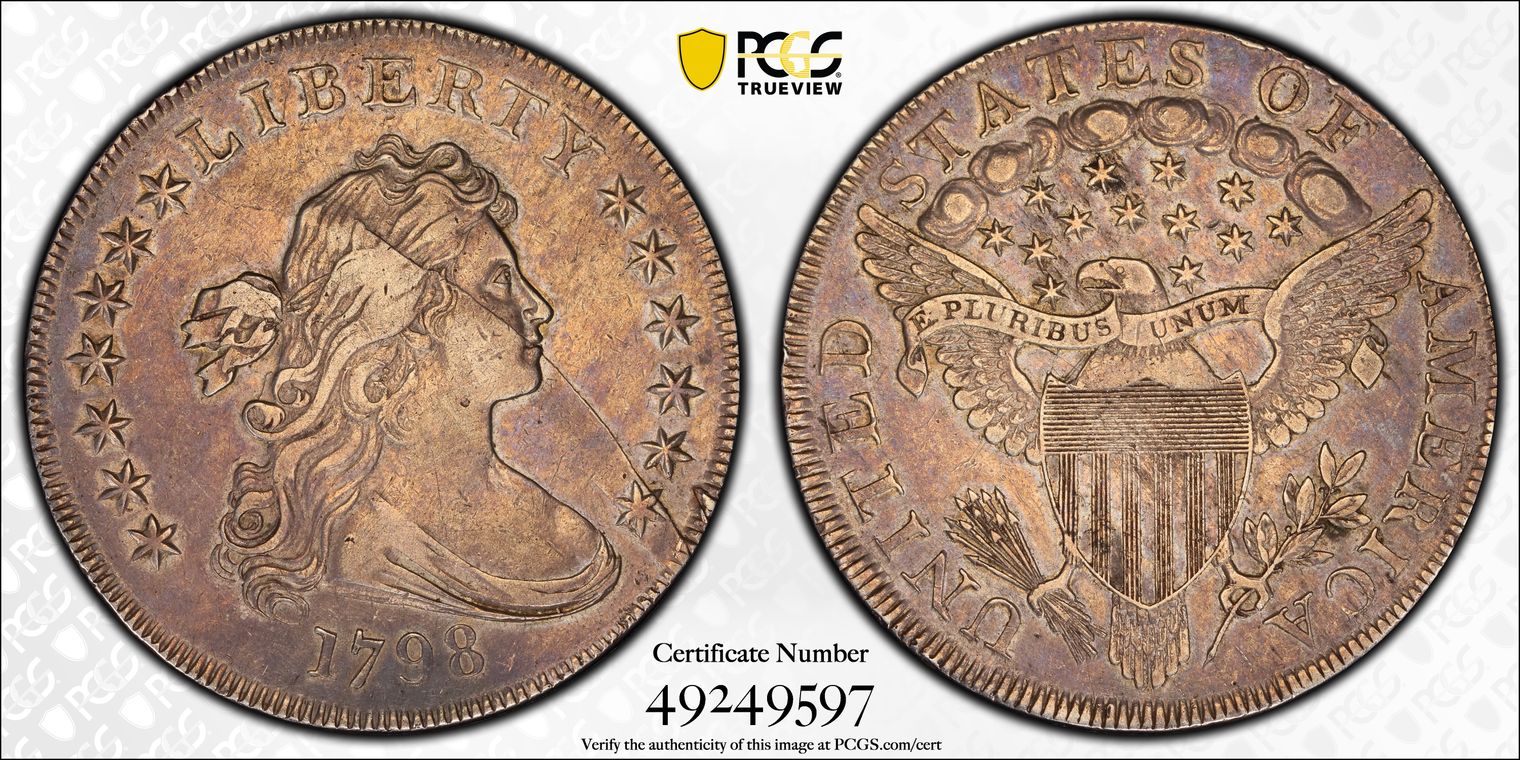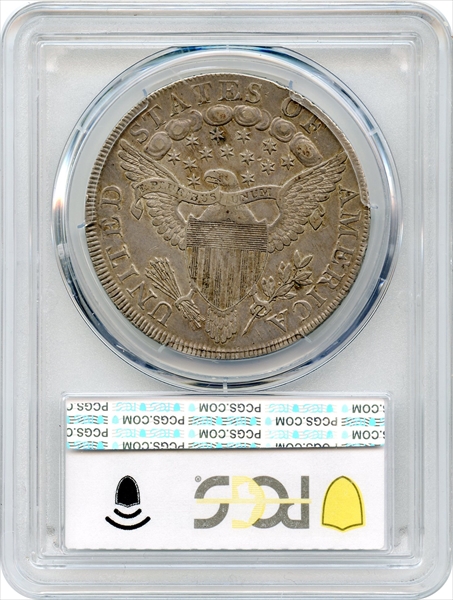1798 $1 BB-111 XF45 认证号49249597, PCGS号40028
拥有者评论
B-11, BB-111. Pointed 9, 4 Lines
专家评论
Q. David Bowers
The following narrative, with minor editing, is from my "Silver Dollars & Trade Dollars of the United States: A Complete Encyclopedia" (Wolfeboro, NH: Bowers and Merena Galleries, Inc., 1993). Note: the Notable Specimens list should be used with caution - it has been updated in my 2013 edition of "The Encyclopedia of United States Silver Dollars 1794-1804."B-11, H-11.
Arc star pattern on reverse.
OBVERSE 11: Medium wide date, 10 mm. across at bottom widest place. First star about as far from curl as upper right star is from Y. The upper left star is closer to L in LIBERTY and about the same distance as last star is from bust. On the left, stars 2-3, 3-4, and 6-7 are spaced wider apart than are the others. On the right, stars 8, 9, 10, and 11 are spaced farther from each other than are stars 11-12 and 12-13. A small clash mark shows just beneath ribbon bow along two highest curls at back of head.
Obverse die used to strike 1798 BB-111 only.
REVERSE K: See description under 1798 BB-110 Reverse die used to strike 1798 BB-110 (1st use), BB-111
(2nd use), BB-112 (3rd use), and BB-113 (4th and final use). See discussion of die states under 1798 BB-110.
DIE STATES:
Die State I: Obverse: Dies with clash mark as described above, but without cracks. Reverse: Unknown to Haseltine. Cf. Davis-Graves Sale: 1285 (Stack's, 1954) VG-8. Rare.
Die State II: As above, but with mound developing below chin.
Die State III: As above, but the mound is more obvious, but hasn't yet developed into a crack.
Die State IV: Bolender-11a. With die crack under chin across three points of last star to border.
Die State V: As above but now with another die crack across hair above ear. Scarce.
Die State VI: With the die cracks as listed by Bolender but now the upper crack is more prominent than the lower crack.
Die State VII: Bolender-11b. As last, but the die crack across hair continues across cheek, mouth, and upper ray of last star to border. This die state is always weak at the obverse center.
Die State VIII: As VII, but now with the extended across the head into the field beyond, toward the L of LIBERTY.
COLLECTING NOTES: 1798 BB-111 is in the medium range of scarcity among dollars of this date. An estimated 250 to 450 exist. A perusal of auction data dramatically reveals that VF is a high grade for this issue, and that an EF specimen is noteworthy. The average grade of F-19 is one of the lower figures among 1798 silver dollars. This issue circulated extensively, to say the least. Does even a full AU coin exist?
NOTABLE SPECIMENS:
Auction '86 Specimen. EF-45. RARCOA "Auction '86" 1986:729. "Bold EF to AU, with underlying lustre and attractive tone. Perfect die state."
Brilliant and Sieck Specimen EF-45. Bowers and Merena, Brilliant and Sieck Collections, 1992:1268. "Deep silver gray on both sides, highly attractive, with some areas of lighter gray on the extreme high points. Rare die state, the obverse severely broken and buckled diagonally across from 10:00 to 4:00, with one very deep linear break extending from the center of Liberty’s head to the rim above the 13th star. Clearly, this die would not have struck very many more coins before it shattered into two separate pieces."
MacFarland Specimen EF-45. Bowers and Ruddy, MacFarland Collection, 1981:1558. "Choice EF-45, nicely toned in shades of gray, greenish gold and blue: considerable underlying mint lustre, especially about the rims. Choice defect-free surfaces, and the piece is well struck up. Perfect die state."
Lighthouse Specimen EF-40. J.C. Lighthouse Collection. Bolender, 1952:53.
Boyd Specimen, EF-40. World's Greatest Collection, F.C.C. Boyd, Numismatic Gallery, 1945:36.
Stirling Specimen. EF-40. Frank M. Stirling Collection, Heritage, February 1986:1337. "Gorgeous gold overtones complement lustrous light gray surfaces."
Lee and Shaffer Specimen, EF-40. Superior, Lee and Shaffer Collections, 1988:3140. "Sharpness of EF-40 or better, but with a number of small but noticeable marks on the obverse; these marks are clustered. above and below LIBERTY and there is a shallow but noticeable scratch in the left obverse field. Some marks on reverse hidden within stars;"
Ostheimer Specimen. VF-35. Lester Merkin; 1968:253. "Nearly EF, considerable mint frost; iridescent sunset toning, clean surfaces; centers weak as usual. Probably ex Boyd.
Spies Specimens. The W. Earl Spies Collection (Stack's, 1974) featured seven progressively different die states, graded VG, VF, VF, VG, VG, VF, and VG (these formed the basis of the die state information given above).
PCGS #
40028
设计师
Robert Scot
边缘
Lettered: HUNDRED CENTS ONE DOLLAR OR UNIT
直径
40.00 毫米
重量
27.00 克
铸币数量
287536
金属成分
90% Silver, 10% Copper
更高评级数量
1
评级较低的钱币数量
8
地区
The United States of America
价格指南
PCGS 数量报告
拍卖 - PCGS 评级的
拍卖 - NGC 评级的
状况普查 了解更多
| #1 PCGS XF45 |
| #2 PCGS XF40 |
| #3 PCGS VF35 |






















